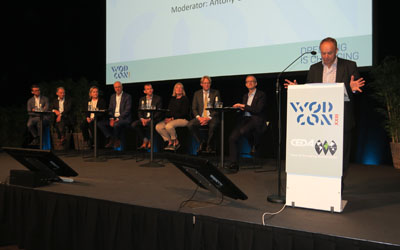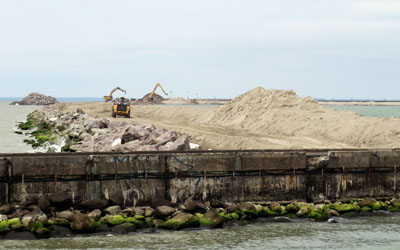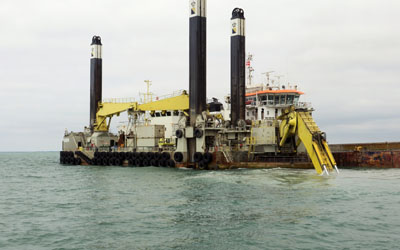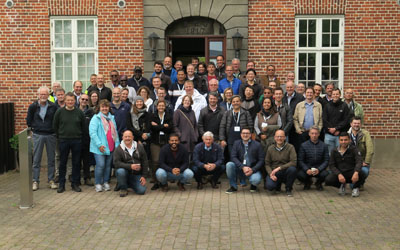
The Corporate Executives Sustainability Discussion
With 400 participants, 35 exhibitors and 15 sponsors from 22 countries all over the world, the WODCON can be considered as the most prestigious gathering in the dredging industry community worldwide.
The WODCON in Copenhagen has been organised by the World Organization of Dredging Associations (WODA), which for the past three years has been chaired by the Central Dredging Association (CEDA).
As an umbrella organisation, WODA covers three separate dredging associations, besides the CEDA these are the Western Dredging Association (WEDA) and the Eastern Dredging Association (EADA).
Each of these organisations serves a specific part of the world: for the WEDA this is North, Central and South America, for the CEDA Europe, Africa and the Middle-East and for the EADA Asia, Australia and the Pacific region.
The WODCON is held once every three years in rotation in one of these parts of the world with the relevant dredging association as main organising body.
On the first day of the congress several meetings of commissions and workgroups of the WODA and the CEDA took place in Copenhagen's Tivoli Congress Center, where the conference took place.
The actual opening ceremony of the WODCON was held in the morning of the 17th of June.
As part of the opening ceremony, a keynote speech was given by the Danish Minister of Transport and Gender Equality, Mrs. Trine Bramsen.
During the three days that followed, many sessions with presentations on various topics were given.
Another project that gained much attention during the WODCON was the construction of the Fehmarnbelt tunnel between Denmark end Germany.
On the last day of the congress, two technical visits have been organised, one of them was to the project Lynetteholm, a 275 ha reclamation near Copenhagen that will offer housing space to 35,000 people while also serve as a protection against the rising water level.
Sources:
These included the WODA Workgroup on Reservoir Dredging, the WODA Environment Commission, the WODA Workgroup on Safety in Dredging and the CEDA Dredging Management Commission (DMC).
Main theme of this year's WODCON was "Dredging is Changing" and as part of that three aspects were mainly focused: the practice, the science and the business.
It is commonly known, our global environment is changing in a pace not known before, it can be noticed in many ways: the climate, the quality of our environment (on land, in the air and under water) and our growing demand for energy as well as for living space.
In general, the quality of the environment that we live in is under threat.
The dredging industry can be one of the main players to counterattack this threat, but then it has to change itself also.
The conferences theme was also highlighted by her and she noted that there are more intricate levels of meaning of 'Dredging is Changing' that evolved over the last decades mainly with respect to the environmental impact of dredging operations.
She mentioned that Denmark amongst others has been one of the forerunners in becoming aware that more thorough understanding of ecosystem dynamics and the development of mitigating measures is vital.
As an example she mentioned the dredging works for the Øresund link in the early nineties.

Reclamation work at Rødbyhaven for the Fehmarnbelt project
The need for change was widely acknowledged during the Corporate Executives Sustainability Discussion which was the first content-related session after the opening ceremony.
During this interactive session, executives of the main European dredging companies (Boskalis, DEME, Jan De Nul, Rohde Nielsen and Van Oord), the ship builder Royal IHC and a Denmark based worldwide consultancy firm (Rambøll) and a main dredging technology consumer (Femern A/S) discussed their view on the current situation, the future and the possibilities of the dredging industry to make the inevitable changes to benefit as much as possible our environment.
Although in detail, the opinions were different on how to achieve this, it was unanimously agreed on that doing nothing is no option.
A very important conclusion was drawn that the best approach could only be reached if the complete dredging industry community was actively involved in stead of only one constituent, like for example only the dredging companies.
From this it can be included that there are two main tracks that the dredging industry can follow, or better said has to follow, to bend the change into a favourable direction.
The first one is changing its own footprint by diverting its main energy source from fossil fuels, in other words decarbonisation, to alternative energy sources that have less and preferably no impact on climate and environment.
Many different kinds of alternatives energy sources were mentioned during the sessions, including LNG and BIO based fuels, but also electricity either from batteries, from tank stored liquids like hydrogen and methanol and by shore delivery, the latter only applicable on stationary dredgers obviously.
Although these solutions seem promising in view of decarbonisation, each of them have their specific pros and cons and it is acknowledged that still much research, development and optimisation is required to find the perfect solution.
In the mean time, the application of alternative energy sources on dredgers involved in actual dredging projects already allows for a certain degree of decarbonisation, while in the same time valuable data can be obtained, amongst other by measurement at the exhaust.
Besides looking at alternative energy sources, this track can also be followed by optimising the dredging process and reducing the overall energy demand of this process.
Leading manufacturer of dredgers and dredging equipment Royal IHC is for quite some time already following this path.
But as already stated, this is a path that all parties involved, authorities, dredging companies, consultants and ship builders can and need to walk together.

Dredging the trench for the Fehmarnbelt project
Besides the track of reducing its own footprint, the dredging can also contribute to projects that will help the decarbonisation in a global sense and this will probably have an even larger impact.
The dredging industry is already largely following this track and many examples have passed during the various WODCON sessions.
The construction of offshore wind mill farms is a field where the dredging industry plays an important role.
At several occasions for example the realisation of energy islands at sea have been treated at the WODCON.
Although there is not yet a fixed definition of the term 'energy island', it is currently used for two different concepts
At first, it concerns islands that will serve as a hub for a series of windmill parks where several functions can be combined, such as being a hub for the energy generated by multiple parks, in this case it is often referred to as a 'power socket'.
But, the islands can also fulfil logistical tasks such as a support for the maintenance of the wind turbines, in this case a sheltered harbour is integrated into the island.
Another concept of 'energy island', is an island which offers the possibility of temporarily storing the wind energy.
In fact, storage of this kind of energy is an essential part of its functionality since by its concept wind energy has a high intermittent character, only storage can make wind energy more reliable.
This kind of energy islands offer the possibility to store the energy by playing with the water level within its surrounding dykes, i.e. pumping the water up during a peak in the energy supply in combination with a low demand and lower the level while the situation is the other way around.
Whatever its concept, in order to realise these islands a large dredging effort is required, but once they have been completed, they will contribute largely in the efficiency of wind energy.
At this moment Denmark is a fore-runner with the 'hub' concept of energy islands with serious plans for realisation in the North Sea and the Baltic Sea.
With a total length of 18 kilometres, this will be the world's largest immersed tunnel.
The Fehmarnbelt tunnel will significantly cut the travel distance and time both for road as for railway traffic between Sweden and Denmark, which are already connected by the Øresund link, on one hand and the rest of Europe on the other hand.
In particular in combination with the construction of a 230 km/h railway line in Denmark, the benefit for railway traffic is spectacular.
Once completed, scheduled for 2029, it is expected to result in a serious reduction of the overall carbon footprint in Europe.
In fact, it is a major step in making railway traffic throughout Europe efficient and attractive and as such making many short distance air links within the continent obsolete.
The subsequent shift from air to railway traffic will be one of the most spectacular savings on CO2 emissions in Europe.
On top of that it is also expected that the freight transport that is currently taking place mainly by road, will shift more to transport by rail, and as such even further reduce CO2 emissions.

Visit to the Fehmarnbelt project at Rødbyhaven
Dredging is a vital activity of the project, not only for the realisation of the tunnel trench, but also for the construction of work harbours and the reclamation of nature friendly areas along the coastline near the tunnel.
The dredging part of the project has been engineered in such a way that not a single cubic metre of dredged material is wasted, the entire amount of dredged material is re-used within the project.
Two joint ventures have been contracted by Femern A/S, a subsidiary of the Danish state-owned company, Sund & Bælt, these are Fehmarn Belt Contractors (FBC) and Fehmarn Link Contractors (FLC).
Many European dredging companies are involved in the construction, either as partner of one of the joint ventures or as a subcontractor.
The other technical visit went to the above mentioned Fehmarnbelt project where visitors could see with their own eyes the current state of the project and the dredging activities at the tunnel's trench.
WODCON 2022
World Organization of Dredging Associations (WODA)
Central Dredging Association (CEDA)
The Fehmarnbelt Tunnel